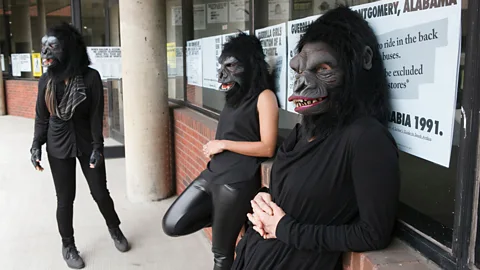The naked billboard that shocked the establishment – and blazed a trail in the art world
 Guerrilla Girls
Guerrilla GirlsIt's been 40 years since the controversial activist group Guerrilla Girls formed. Their most powerful campaign, the "naked poster", broke new ground – and has had a lasting influence.
On a Sunday morning in New York in 1989, a few women perused the permanent collection of the Metropolitan Museum of Art. Hidden among the regular punters, the anonymous feminist art collective, the Guerrilla Girls, went unnoticed as they carefully counted the number of female artists versus the number of naked women depicted in the artworks. They were on a secret mission to make people care about the racial and gender unfairness of the art world.
 Guerrilla Girls
Guerrilla Girls"The idea always was to find that kernel that was unforgettable," one of the founding of the Guerrilla Girls, who uses the alias Käthe Kollwitz, tells the BBC at the National Museum of Women in the Arts, ahead of an exhibition that celebrates 40 years of their work.
They made their way through the different rooms – past the male nudes of ancient Greece and the near absence of nudity in the early Christian sections – but it was when they hit the early modern era that they found the statistics that would lead to their biting criticism of the art world. They posed the question of who was allowed to be subject and object in the lofty corridors of the world's most prestigious art institutions.
"Less than 5% of the artists in the Modern Art Sections are women, but 85% of the nudes are female," reads the poster, next to a female nude whose head is covered by the group's trademark gorilla mask. The figure is based on the painting La Grande Odalisque, 1814, by male painter Jean-Auguste-Dominique Ingres.
To this day, the group remains anonymous, and when the BBC interviews Kollwitz, she is wearing the mask. "I don't think anyone who actually looks at that poster can go into a museum and not think about what is on the walls and why," she says.
 Andrew Hinderaker
Andrew HinderakerThe Do Women Have to Be Naked to Get into the Met Museum? poster was meant to have been a commission from the New York Public Art Fund, but on seeing the final result, the funding was pulled. The Guerrilla Girls committed to their message and put it on billboards and buses themselves. "We decided to buy space on NYC buses. We also pasted it up ourselves on NYC streets."
The poster threw the collective into the spotlight and cemented their style with a mass audience. The mix of humour, statistics and bold advertising slogans was the culmination of several years of working out how to tackle gender and racial inequality. The group's initial two posters – What Do These Artists Have in Common? and These Galleries Show No More Than 10% Women Artists or None at All – were plastered on walls, street lamps and telephone booths in New York, with no need for permission from the decisions of those who ran the powerful art institutions.
The Guerrilla Girls' decision to adopt the language of advertising was in reaction to what they saw as the ineffectiveness of traditional protests. The group formed in 1985 after attending a protest outside the Museum of Modern Art in New York the previous year. The International Survey of Recent Painting and Sculpture had only featured 17 women and eight artists of colour out of 169 artists.
"A couple of us went to this protest, and it was so clear nobody cared. Everyone just went inside the museum. You know, all these signs about women's art. They didn't believe it for a minute. And that was really the 'aha' moment."
 Getty Images
Getty ImagesThe "Naked" poster, as Kollwitz refers to it, was a game-changer. "We often have crazy visuals, facts, and humour – things to draw them in – and if you actually look at our posters, you'll never see art quite the same way again."
'Undeniable change'
Author and podcaster Katy Hessel, in her book The Story of Art Without Men, points to how artists coming up through the '80s had all grown up with televisions in their homes. "Playing with the media (and art history's) stereotypes of women, they took back control of the gaze and turned it upon themselves."
"The Guerrilla Girls brought public attention to the inequalities and systematic discrimination in the art world, and ultimately asked – just how did museums get away with celebrating the history of patriarchy instead of the history of art">window._taboola = window._taboola || []; _taboola.push({ mode: 'alternating-thumbnails-a', container: 'taboola-below-article', placement: 'Below Article', target_type: 'mix' });
